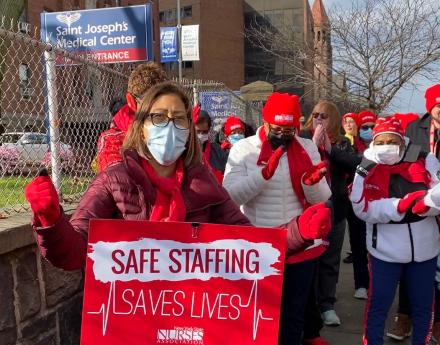Research Shows Safe Staffing Saves Lives
Image

Nurses know that safe staffing levels save lives — and the research is on our side. Clinical and academic studies show that safe staffing improves patient outcomes and even saves money. And highly regarded reports show that New York State would have been better prepared and seen fewer deaths during the coronavirus pandemic if there had been safe staffing standards in hospitals and nursing homes. Both the New York Attorney General and researcher Dr. Linda Aiken, PhD, RN, FAAN, FRCN, released studies in 2021 showing that thousands of lives could have been saved if New York State facilities had adequate staffing during the pandemic. The facts line up with nurses’ experiences that safe staffing protects patients.
SAFE STAFFING SAVES LIVES
- Hospitals that staff 1:8 nurse-to-patient ratios experience five additional deaths per 1,000 patients than a 1:4 nurse-to-patient ratio (Journal of the American Medical Association, 2002).
- The odds of patient death increases by 7% for each additional patient the nurse must take on at one time (Journal of the American Medical Association, 2002).
- Outcomes are better for patients when staffing levels meet those established in California, including an increase in lives saved, shorter hospital stays, and general improvement in quality care (Health Services Research, 2010).
- A study by Dr. Linda H Aiken, PhD, RN, FAAN, FRCN, estimates that there would have been 4,370 fewer in-hospital deaths in a 2-year period among Medicare patients if New York State hospitals had implemented safe staffing during the time of the study. (Medical Care, 2021).
- Nursing homes in New York state that entered the pandemic with lower staffing scores saw higher fatality rates (NYS Office of the Attorney General, 2021).
LOWER RATIOS DO NOT CLOSE HOSPITALS AND ARE COST-EFFECTIVE!
- After ratios were implemented in California, hospital income rose dramatically from $12.5 billion to more than $20.6 billion
- Some hospital managers reported that ratios actually made it easier to secure funding for hospitals (California Health Care Foundation)
- Increased nurse staffing is a more cost-effective tactic to improve patient care when compared to other interventions (Nursing Administration Quarterly, 2011).
- Safe nurse staffing reduces turnover in hospitals. When ratios are blown out of proportion, there is an increase in nursing turnover and a decrease in patient satisfaction. All of this increases the cost of care (Nursing Administration Quarterly, 2011).
- Turnover is expensive—the average cost to replace an RN ranges from $82,000 to $88,000 (The Journal of Nursing Administration, 2008).
- Nurse understaffing in hospital ICU increases the risk of infections like pneumonia, which not only lead to injury and death, but also cost the hospital significant amount of money. Hospital-acquired pressure ulcers alone have been estimated to cost $8.5 billion per year (Agency for Healthcare Quality and Research Pub. No. 04-0029, 2004).
Facilities have the flexibility to assign nurses fewer patients than the set ratios if appropriate. - Ancillary staff remain vital to healthcare—California hospitals did not decide to cut non-nursing jobs as a result of safe staffing ratios in effort to cut costs.
- If New York state hospitals had safe staffing in the two-year period prior to the pandemic, they would have saved $720 million because of avoided days of hospital care from shorter lengths of stay and fewer readmissions from better nurse staffing. (Medical Care, 2021).
SAFE STAFFING REDUCES ADVERSE OUTCOMES
- Length of stay, urinary tract infections, cases of upper gastrointestinal bleeding all increased due to unsafe staffing ratios (New England Journal of Medicine, 346 (22) 1715-1722)
- Rates of hospital-acquired pneumonia and shock or cardiac arrest, as well as a failure to rescue climbed due to unsafe staffing (New England Journal of Medicine, 346 (22) 1715-1722)
- For patients admitted to hospitals with sepsis, each additional patient per nurse is associated with 12% higher odds of in-hospital mortality, 7% higher odds of 60-day mortality [and] 7% higher odds of 60-day readmission….” (American Journal of Infection Control, 2020).
